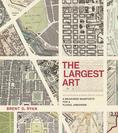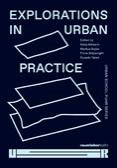city-regions design paesaggio resilience populations culture creativity city innovation anthropology rural areas immigration urban africa globalization heritage composition welfare housing cartography inclusive processes industrial sites large scale plans & projects competition citizenship conferences
The Largest Art
A Measured Manifesto for a Plural Urbanism
Edited by Brent D.Ryan
pp. 384, 2017 | ISBN 978026234192
Urban design in practice is incremental, but architects imagine it as scaled-up architecture—large, ready-to-build pop-up cities. This paradox of urban design is rarely addressed; indeed, urban design as a discipline lacks a theoretical foundation. In The Largest Art, Brent Ryan argues that urban design encompasses more than architecture, and he provides a foundational theory of urban design beyond the architectural scale. In a “declaration of independence” for urban design, Ryan describes urban design as the largest of the building arts, with qualities of its own.
Ryan distinguishes urban design from its sister arts by its pluralism: plural scale, ranging from an alleyway to a region; plural time, because it is deeply enmeshed in both history and the present; plural property, with many owners; plural agents, with many makers; and plural form, with a distributed quality that allows it to coexist with diverse elements of the city. Ryan looks at three well-known urban design projects through the lens of pluralism: a Brancusi sculptural ensemble in Romania, a Bronx housing project, and a formally and spatially diverse grouping of projects in Ljubljana, Slovenia. He revisits the thought of three plural urbanists working between 1960 and 1980: David Crane, Edmund Bacon, and Kevin Lynch. And he tells three design stories for the future, imaginary scenarios of plural urbanism in locations around the world. Ryan concludes his manifesto with three signal considerations urban designers must acknowledge: eternal change, inevitable incompletion, and flexible fidelity. Cities are ceaselessly active, perpetually changing. It is the urban designer’s task to make art with aesthetic qualities that can survive perpetual change.
CONTENTS
Preface | ix
1. Unitary Architecture, Plural Cities | 1
2. Five Dimensions of Plural Urbanism | 39
3. Three Pluralist Projects | 115
4. Three Plural Urbanists | 163
5. Designing Pluralist Urbanism | 223
6. Principles and Potentials of Plural Urbanism | 265
Acknowledgments | 311
Notes | 313
Bibliography | 333
Illustration Credits | 345
Index | 351
ABOUT THE EDITOR
Brent D. Ryan is Head of the City Design and Development Group and Associate Professor of Urban Design and Public Policy in MIT’s Department of Urban Studies and Planning. His research focuses on the aesthetics and policies of contemporary urban design, particularly with respect to current and pressing issues like deindustrialization and climate change. Professor Ryan’s first book Design After Decline: How America rebuilds shrinking cities, was selected by Planetizen as one of its ten best urban planning books of 2012, and his second book, a treatise on urban design as a plural art, will be published by MIT Press in 2017.
Related articles:




Planum
The Journal of Urbanism
ISSN 1723-0993
owned by
Istituto Nazionale di Urbanistica
published by
Planum Association
ISSN 1723-0993 | Registered at Court of Rome 4/12/2001, num. 514/2001
Web site realized by ChannelWeb & Planum Association | Powered by BEdita 3






















